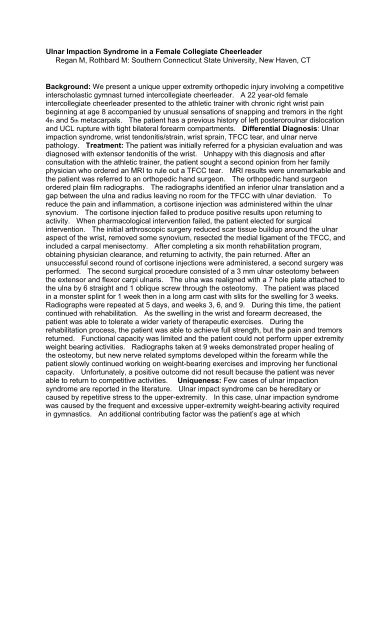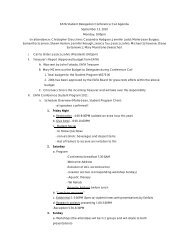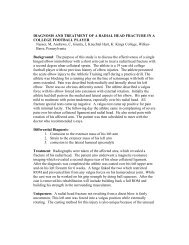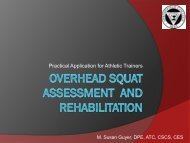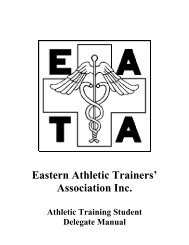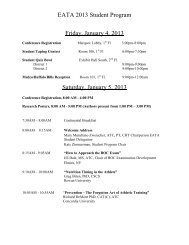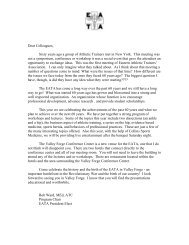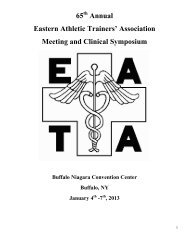Ulnar Impaction Syndrome in a Female Collegiate Cheerleader ...
Ulnar Impaction Syndrome in a Female Collegiate Cheerleader ...
Ulnar Impaction Syndrome in a Female Collegiate Cheerleader ...
Create successful ePaper yourself
Turn your PDF publications into a flip-book with our unique Google optimized e-Paper software.
<strong>Ulnar</strong> <strong>Impaction</strong> <strong>Syndrome</strong> <strong>in</strong> a <strong>Female</strong> <strong>Collegiate</strong> <strong>Cheerleader</strong><br />
Regan M, Rothbard M: Southern Connecticut State University, New Haven, CT<br />
Background: We present a unique upper extremity orthopedic <strong>in</strong>jury <strong>in</strong>volv<strong>in</strong>g a competitive<br />
<strong>in</strong>terscholastic gymnast turned <strong>in</strong>tercollegiate cheerleader. A 22 year-old female<br />
<strong>in</strong>tercollegiate cheerleader presented to the athletic tra<strong>in</strong>er with chronic right wrist pa<strong>in</strong><br />
beg<strong>in</strong>n<strong>in</strong>g at age 8 accompanied by unusual sensations of snapp<strong>in</strong>g and tremors <strong>in</strong> the right<br />
4th and 5th metacarpals. The patient has a previous history of left posteroroulnar dislocation<br />
and UCL rupture with tight bilateral forearm compartments. Differential Diagnosis: <strong>Ulnar</strong><br />
impaction syndrome, wrist tendonitis/stra<strong>in</strong>, wrist spra<strong>in</strong>, TFCC tear, and ulnar nerve<br />
pathology. Treatment: The patient was <strong>in</strong>itially referred for a physician evaluation and was<br />
diagnosed with extensor tendonitis of the wrist. Unhappy with this diagnosis and after<br />
consultation with the athletic tra<strong>in</strong>er, the patient sought a second op<strong>in</strong>ion from her family<br />
physician who ordered an MRI to rule out a TFCC tear. MRI results were unremarkable and<br />
the patient was referred to an orthopedic hand surgeon. The orthopedic hand surgeon<br />
ordered pla<strong>in</strong> film radiographs. The radiographs identified an <strong>in</strong>ferior ulnar translation and a<br />
gap between the ulna and radius leav<strong>in</strong>g no room for the TFCC with ulnar deviation. To<br />
reduce the pa<strong>in</strong> and <strong>in</strong>flammation, a cortisone <strong>in</strong>jection was adm<strong>in</strong>istered with<strong>in</strong> the ulnar<br />
synovium. The cortisone <strong>in</strong>jection failed to produce positive results upon return<strong>in</strong>g to<br />
activity. When pharmacological <strong>in</strong>tervention failed, the patient elected for surgical<br />
<strong>in</strong>tervention. The <strong>in</strong>itial arthroscopic surgery reduced scar tissue buildup around the ulnar<br />
aspect of the wrist, removed some synovium, resected the medial ligament of the TFCC, and<br />
<strong>in</strong>cluded a carpal menisectomy. After complet<strong>in</strong>g a six month rehabilitation program,<br />
obta<strong>in</strong><strong>in</strong>g physician clearance, and return<strong>in</strong>g to activity, the pa<strong>in</strong> returned. After an<br />
unsuccessful second round of cortisone <strong>in</strong>jections were adm<strong>in</strong>istered, a second surgery was<br />
performed. The second surgical procedure consisted of a 3 mm ulnar osteotomy between<br />
the extensor and flexor carpi ulnaris. The ulna was realigned with a 7 hole plate attached to<br />
the ulna by 6 straight and 1 oblique screw through the osteotomy. The patient was placed<br />
<strong>in</strong> a monster spl<strong>in</strong>t for 1 week then <strong>in</strong> a long arm cast with slits for the swell<strong>in</strong>g for 3 weeks.<br />
Radiographs were repeated at 5 days, and weeks 3, 6, and 9. Dur<strong>in</strong>g this time, the patient<br />
cont<strong>in</strong>ued with rehabilitation. As the swell<strong>in</strong>g <strong>in</strong> the wrist and forearm decreased, the<br />
patient was able to tolerate a wider variety of therapeutic exercises. Dur<strong>in</strong>g the<br />
rehabilitation process, the patient was able to achieve full strength, but the pa<strong>in</strong> and tremors<br />
returned. Functional capacity was limited and the patient could not perform upper extremity<br />
weight bear<strong>in</strong>g activities. Radiographs taken at 9 weeks demonstrated proper heal<strong>in</strong>g of<br />
the osteotomy, but new nerve related symptoms developed with<strong>in</strong> the forearm while the<br />
patient slowly cont<strong>in</strong>ued work<strong>in</strong>g on weight-bear<strong>in</strong>g exercises and improv<strong>in</strong>g her functional<br />
capacity. Unfortunately, a positive outcome did not result because the patient was never<br />
able to return to competitive activities. Uniqueness: Few cases of ulnar impaction<br />
syndrome are reported <strong>in</strong> the literature. <strong>Ulnar</strong> impact syndrome can be hereditary or<br />
caused by repetitive stress to the upper-extremity. In this case, ulnar impaction syndrome<br />
was caused by the frequent and excessive upper-extremity weight-bear<strong>in</strong>g activity required<br />
<strong>in</strong> gymnastics. An additional contribut<strong>in</strong>g factor was the patient’s age at which
gymnastics was started. The underly<strong>in</strong>g cause was believed to be premature clos<strong>in</strong>g of<br />
the radial physes due to excessive upper extremity weight-bear<strong>in</strong>g demands placed on the<br />
patient’s develop<strong>in</strong>g body. Conclusions: Due to the rareness of this <strong>in</strong>jury, cl<strong>in</strong>icians must<br />
be aware of a patient’s previous medical history, identify the mechanism of <strong>in</strong>jury, and be<br />
able to recognize symptoms that may <strong>in</strong>clude tremors <strong>in</strong> conjunction with ulnar wrist pa<strong>in</strong>.<br />
Word Count: 598


